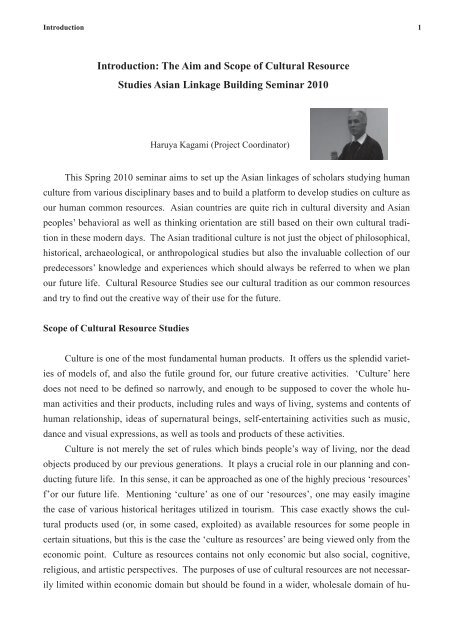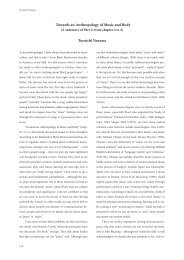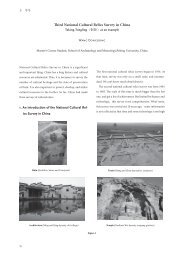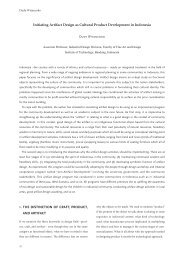Introduction: The Aim and Scope of Cultural Resource Studies Asian ...
Introduction: The Aim and Scope of Cultural Resource Studies Asian ...
Introduction: The Aim and Scope of Cultural Resource Studies Asian ...
You also want an ePaper? Increase the reach of your titles
YUMPU automatically turns print PDFs into web optimized ePapers that Google loves.
<strong>Introduction</strong><br />
1<br />
<strong>Introduction</strong>: <strong>The</strong> <strong>Aim</strong> <strong>and</strong> <strong>Scope</strong> <strong>of</strong> <strong>Cultural</strong> <strong>Resource</strong><br />
<strong>Studies</strong> <strong>Asian</strong> Linkage Building Seminar 2010<br />
Haruya Kagami (Project Coordinator)<br />
This Spring 2010 seminar aims to set up the <strong>Asian</strong> linkages <strong>of</strong> scholars studying human<br />
culture from various disciplinary bases <strong>and</strong> to build a platform to develop studies on culture as<br />
our human common resources. <strong>Asian</strong> countries are quite rich in cultural diversity <strong>and</strong> <strong>Asian</strong><br />
peoples’ behavioral as well as thinking orientation are still based on their own cultural tradition<br />
in these modern days. <strong>The</strong> <strong>Asian</strong> traditional culture is not just the object <strong>of</strong> philosophical,<br />
historical, archaeological, or anthropological studies but also the invaluable collection <strong>of</strong> our<br />
predecessors’ knowledge <strong>and</strong> experiences which should always be referred to when we plan<br />
our future life. <strong>Cultural</strong> <strong>Resource</strong> <strong>Studies</strong> see our cultural tradition as our common resources<br />
<strong>and</strong> try to find out the creative way <strong>of</strong> their use for the future.<br />
<strong>Scope</strong> <strong>of</strong> <strong>Cultural</strong> <strong>Resource</strong> <strong>Studies</strong><br />
Culture is one <strong>of</strong> the most fundamental human products. It <strong>of</strong>fers us the splendid varieties<br />
<strong>of</strong> models <strong>of</strong>, <strong>and</strong> also the futile ground for, our future creative activities. ‘Culture’ here<br />
does not need to be defined so narrowly, <strong>and</strong> enough to be supposed to cover the whole human<br />
activities <strong>and</strong> their products, including rules <strong>and</strong> ways <strong>of</strong> living, systems <strong>and</strong> contents <strong>of</strong><br />
human relationship, ideas <strong>of</strong> supernatural beings, self-entertaining activities such as music,<br />
dance <strong>and</strong> visual expressions, as well as tools <strong>and</strong> products <strong>of</strong> these activities.<br />
Culture is not merely the set <strong>of</strong> rules which binds people’s way <strong>of</strong> living, nor the dead<br />
objects produced by our previous generations. It plays a crucial role in our planning <strong>and</strong> conducting<br />
future life. In this sense, it can be approached as one <strong>of</strong> the highly precious ‘resources’<br />
f’or our future life. Mentioning ‘culture’ as one <strong>of</strong> our ‘resources’, one may easily imagine<br />
the case <strong>of</strong> various historical heritages utilized in tourism. This case exactly shows the cultural<br />
products used (or, in some cased, exploited) as available resources for some people in<br />
certain situations, but this is the case the ‘culture as resources’ are being viewed only from the<br />
economic point. Culture as resources contains not only economic but also social, cognitive,<br />
religious, <strong>and</strong> artistic perspectives. <strong>The</strong> purposes <strong>of</strong> use <strong>of</strong> cultural resources are not necessarily<br />
limited within economic domain but should be found in a wider, wholesale domain <strong>of</strong> hu-
2 Haruya Kagami<br />
man activities.<br />
To make the concept <strong>of</strong> ‘culture as resources’ more clear <strong>and</strong> accurate, let me compare it<br />
with natural resources. In the modern era, nature has tended to be viewed <strong>and</strong> treated only as<br />
the useful resources for human beings. If we can get out <strong>of</strong> this modern economically-oriented<br />
scope <strong>of</strong> nature as resources, we soon recognize that nature plays a greater role in binding<br />
peoples’ way <strong>of</strong> life <strong>and</strong> <strong>of</strong>fers the futile grounds for human activities. Nature should not be<br />
viewed only as the object <strong>of</strong> economic exploitation but as a living whole within which human<br />
beings should find a field <strong>of</strong> their lives. <strong>The</strong> recent world-wide ecology movements explicitly<br />
raise this kind <strong>of</strong> scope for nature.<br />
<strong>The</strong> concept <strong>of</strong> culture as resources, thus, does not mean to stress the possibility <strong>of</strong> economic<br />
exploitation <strong>of</strong> cultural resources. On the contrary, it views culture as a rich storehouse<br />
full <strong>of</strong> accumulated human knowledge <strong>and</strong> experiences as well as a futile field for future creative<br />
human activities. In other words, culture can be approached as a kind <strong>of</strong> resources in so<br />
far as it is treated not as the object <strong>of</strong> economic exploitation but as inherited whole <strong>of</strong> human<br />
knowledge <strong>and</strong> experiences within which we plan to create our future life.<br />
Another point we can extract from the comparison <strong>of</strong> nature <strong>and</strong> culture as resources is<br />
the importance <strong>of</strong> diversity. As the natural diversity is the key phenomena <strong>of</strong> nature life, so<br />
the cultural diversity is for human life. As the diversity <strong>of</strong> species ensure the resilience <strong>of</strong> the<br />
environmental whole, so the cultural diversity <strong>of</strong>fers the more futile grounds for human creativity.<br />
For the concept <strong>of</strong> culture as resources, the issue <strong>of</strong> ownership cannot be passed-by. On<br />
this matter, too, the comparison with natural resources gives us a hint to treat it. In the environmental<br />
issues the concept <strong>of</strong> ‘commons’ plays the central role. In considering the ownership<br />
<strong>of</strong> cultural resources, ‘collective ownership’ would be the key concept to avoid the conflicts<br />
over the ownership or authorship <strong>of</strong> cultural products. <strong>The</strong> idea <strong>of</strong> personally exclusive<br />
ownership itself is one <strong>of</strong> the most powerful <strong>and</strong> influential concepts which has been driving<br />
the modernization <strong>of</strong> the world. This concept <strong>of</strong> personal ownership is firmly combined with<br />
the exploitative process <strong>of</strong> natural resources. <strong>The</strong> idea <strong>of</strong> commons serves as a guarding fortress<br />
against the exploitative power <strong>of</strong> personal ownership concept. Nevertheless, the idea <strong>of</strong><br />
commons or <strong>of</strong> collective ownership could not solve the issue <strong>of</strong> ownership entirely, for there<br />
may still remain the conflicts over the possible host <strong>of</strong> ownership, such as whether the host <strong>of</strong><br />
collective ownership may be a local community, an ethnic group, a nation or universal human<br />
beings.<br />
Accessibility is the key point to h<strong>and</strong>le the problems caused by the idea <strong>of</strong> ownership.<br />
<strong>The</strong> idea <strong>of</strong> personal ownership is used to assert the right <strong>of</strong> exclusive access by the owner to<br />
his own resources. <strong>The</strong> limits <strong>of</strong> access are set to secure the owners’ economic pr<strong>of</strong>its. On the<br />
contrary, the idea <strong>of</strong> commons allows the open access to the common resources, <strong>and</strong> pr<strong>of</strong>its
<strong>Introduction</strong><br />
3<br />
from resources are thought to be shared collectively. <strong>The</strong> idea <strong>of</strong> personal ownership is illfitted<br />
to cultural resources, because their basic elements such as languages, characters, sounds,<br />
rhythms, body postures etc. are our common human resources. Nobody would claim that a<br />
certain language be owned exclusively by a certain nation or an ethnic group. At most a certain<br />
expressive style composed <strong>of</strong> these elements could be claimed as the products <strong>of</strong>, hence<br />
those owned by, a certain nation or an ethnic group. But in such a case, too, open access to<br />
such products would not cause significant loss for their owners. To stimulate further creative<br />
composition, it seems wiser not to limit the access to these cultural products.<br />
While some natural resources such as oil <strong>and</strong> other minerals would be exhausted by<br />
over-exploitation, cultural resources such as knowledge <strong>and</strong> experiences, or literature, music<br />
<strong>and</strong> performances, would never be. But they may extinguish when the socio-cultural environment<br />
sustaining these activities <strong>and</strong> their products is destroyed. <strong>The</strong> existence <strong>of</strong> cultural<br />
resources fully depends on their socio-cultural background from which these were originated.<br />
<strong>The</strong> vast <strong>and</strong> abrupt changes <strong>of</strong> peoples’ way <strong>of</strong> living, especially those caused by modernization,<br />
would threaten the existence <strong>of</strong> diverse local cultures in the world. Although it may not<br />
be true that the modernization homogenize the world in its cultural domain, it surely weakens<br />
the locally oriented cultural activities.<br />
When we approach to diverse cultures in the world as our common resources, the most<br />
crucial point is their rich diversity itself. By referring to vast knowledge <strong>and</strong> experiences<br />
stored in diverse local cultures, <strong>and</strong> through borrowing various cultural products inherited<br />
from past generations as a model or a source <strong>of</strong> inspiration, we could more freely plan <strong>and</strong><br />
create our future life. For that purpose, it is indispensable to establish the way for mutual<br />
open access, too.<br />
Thus, the aim <strong>of</strong> the cultural resource studies is to be set to record the diverse cultural activities<br />
<strong>and</strong> their products in the world, to underst<strong>and</strong> their contents <strong>and</strong> meanings in the original<br />
cultural setting, <strong>and</strong> to <strong>of</strong>fer them for other peoples as a source <strong>of</strong> further inspiration.<br />
<strong>The</strong> expected points <strong>of</strong> discussion<br />
<strong>The</strong> main aim <strong>of</strong> this Spring 2010 program is to exchange opinions <strong>and</strong> share the information<br />
from several countries in order to reach the common view <strong>of</strong> culture as our resources.<br />
During this three weeks seminar program, we hope to discuss not only on the general concept<br />
<strong>of</strong> cultural resource studies but also on the particular cultural condition in each participant’s<br />
own country, government policies <strong>and</strong> social movements concerning traditional culture, the<br />
impact <strong>of</strong> the modernization <strong>and</strong> globalization, <strong>and</strong> the confronting problems to explore the<br />
creative use <strong>of</strong> cultural tradition. We will discuss the matters from several disciplinary points<br />
<strong>of</strong> view including anthropology, archaeology, architectural history, philology, ethnobotany <strong>and</strong>
4 Haruya Kagami<br />
environmental studies based on the participants’ as well as Kanazawa University staffs’ own<br />
academic background.<br />
<strong>The</strong> expected points <strong>of</strong> discussion during the seminar are as follows:<br />
How to discover, recognize <strong>and</strong> record the cultural resources in a given setting?<br />
the way <strong>of</strong> social <strong>and</strong> academic recognition<br />
the way <strong>of</strong> research method<br />
the way <strong>of</strong> management <strong>of</strong> the records<br />
How to preserve given cultural resources?<br />
in the case <strong>of</strong> tangible objects : monuments, sites, tools<br />
in the case <strong>of</strong> intangible objects : performances, rituals, customs, knowledge, believes<br />
How to socialize cultural resources for common use?<br />
to the community itself : cooperating with community development group<br />
to the outer world : academically, politically, economically<br />
<strong>The</strong>se are just the tentative guideline <strong>and</strong> we hope our seminar discussion may bear<br />
fruitful basement for cultural resource studies sustained by our <strong>Asian</strong> scholars linkages.






